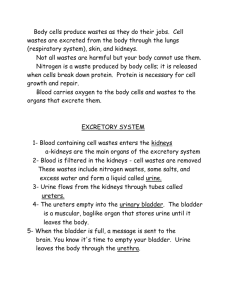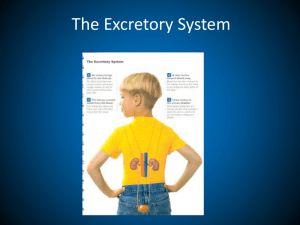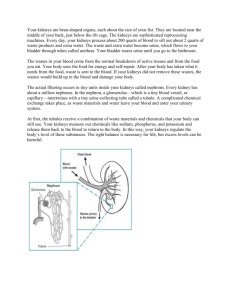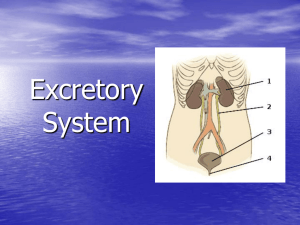B-6 Notes
advertisement
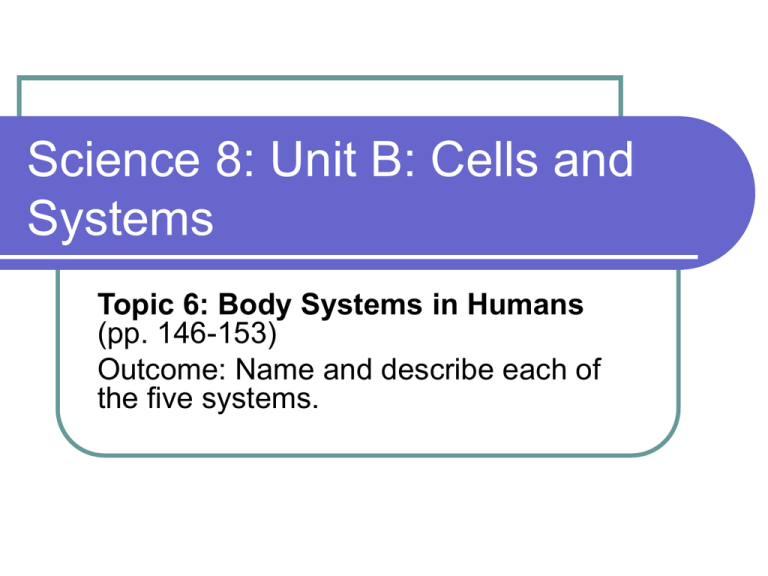
Science 8: Unit B: Cells and Systems Topic 6: Body Systems in Humans (pp. 146-153) Outcome: Name and describe each of the five systems. I. Digestive System Principal Organs: Mouth, esophagus, liver, pancreas, stomach, small and large intestines. Major Role: Digesting food into small particles which can be changed into energy by cells’ mitochondria. Needs Fulfilled: Energy, growth, and eliminating wastes II. Respiratory System Principal organs: Larynx, trachea, bronchi, bronchioles, lungs, diaphragm, alveoli. Major role: Taking in oxygen into the bloodstream, and expelling carbon dioxide. (gas exchange) Needs fulfilled: Energy and eliminating wastes. III. Circulatory System Principal Organs: Heart, arteries, capillaries, veins. Major Role: Transporting nutrients to cells and waste products away from cells. Needs Fulfilled: Energy, eliminating wastes. (Vital for all needs really). IV. Excretory System Principal Organs: Kidneys, ureters, urethra, bladder. Major Role: Filtering and expelling liquid wastes out of body. Needs Fulfilled: Eliminating wastes. V. Sensory Awareness System Principal Organs: Brain- hypothalamus, sensory nerves, motor nerves, muscles, blood vessels, skin, hair. (Really a combination of systems working together, coordinated by the brain.) Major Role: Adjusting body’s different systems to deal with outside environment. Needs Fulfilled: Adapting to environment. Circulatory System Overview I. Heart - the PUMP of the system. II. Arteries - Blood vessels which take blood AWAY from heart to rest of body. They are located deep inside your body so that they are safe from damage. Their thick, muscular walls keep pushing blood to all parts of the body. III. Capillaries - Tiny blood vessels, which are on cell thick. Nutrients (glucose, oxygen, protein, etc.) and wastes (carbon dioxide, urea, etc.) pass back and forth its walls through the process of DIFFUSION. Every cell in your body is in close contact with a capillary. Circulatory System Overview IV. Veins - Blood vessels which take blood TO the heart. Blood in veins is low in nutrients and high in wastes so veins also travel to kidneys and lungs to get rid of waste products. Unlike arteries, veins do not have the muscular walls to push blood to the heart. Instead, veins have valves, which block blood from going backwards. Veins also move blood as they are moved by muscles. This is why cashiers and other people who have to stand still for long periods of time are at risk for damaged veins, and poor circulation (varicose veins) Blood V. Blood - made up of four parts: plasma, red blood cells, white blood cells, and platelets. The job of blood is to carry nutrients to cells while moving wastes away from cells. 1. Plasma - The liquid portion of blood. Actually yellowish in color, plasma is mostly water with the rest being proteins ~ 55% of blood is plasma 2. Red Blood Cells - These disk-like cells carry the oxygen molecules that the cells need and the carbon dioxide molecules the cells need to get rid of. ~ 40 % of blood. Blood Cont’d 3. White Blood Cells (WBC) - Help defend the body against infectious diseases and foreign particles. Also part of the immune system ~ 4% of blood. 4. Platelets - Responsible for blood clotting anytime there is a wound. ~ 1% of blood. Excretory System Overview The Excretory System is the system responsible for filtering out and removing wastes from the body. This system has four main parts: kidneys, ureters, a urethra, and a bladder. I. Kidneys - most important part of system. They filter out wastes from bloodstream and processes them into urine. Excretory System Overview II. Ureters - Two tubes which move urine from kidneys to bladder. A small amount of urine is moved every 10 seconds. III. Bladder - Stores urine until limit is reached and nerve sensors are triggered. The urge to urinate begins here. Excretory System Overview IV. Urethra - Tube that passes urine from bladder to exit point. Sensory Awareness System Not really a body system on its own, but a group of responses coordinated by the brain and carried out by different parts of the muscular, nervous, digestive, and excretory systems. Your skin is fitted with sensory nerves all along its inside. There ar edifferents types of sensory nerves: for pain, pressure, temperature, etc. Sensory Awareness System If the temperature of your skin goes past certain limits, your brain takes action. If the sensory nerves signal that your skin is too cold, your brain sends signals to your muscles to start quivering, causing you to shiver. This rapid movement of muscles causes you to warm up your body temperature. Sensory Awareness System If the sensory nerves signal that your skin is too hot, your brain sends signals to blood vessels near your skin to expand, releasing more heat to the outside. It also sends signals to other systems to save water and to excrete solutes. This causes you to sweat. Sensory Awareness System Sometimes a stimulus needs such an immediate reaction that the signal doesn’t even go to the brain. Instead, reflex reactions travel from a sensory nerve, go to the spinal cord and travel back down to a muscle nerve which performs the response. This is all automatic and does involve the brain at all. An example includes the knee-jerk reaction or placing your hand on a hot surface. The heat from the surface was the stimulus and the reflex reaction was you jerking your hand away.
